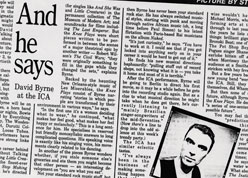ORIGINAL
PRESS CLIPPINGS

BITE-SIZE THEATER
Four people in white outfits, their heads covered with white, pointed hoods, bring on a wooden puppet — the skeleton of a man. As the musicians play a melodic musical phrase in a slow, hypnotic pattern, the white figures hold the puppet high in the air and move his limbs by manipulating long, thin poles. Suddenly a wildly coiffed woman in a brown robe races on stage and assumes a startling Kabuki pose.
An important aspect of "the CIVIL warS" is its international flavor. In different segments Mr. Wilson has worked with German, Argentinean and Japanese, as well as American colleagues. His two chief collaborators in "The Knee Plays" are the Japanese choreographer Suzushi Hanayagi and Mr. Byrne.
A founding member of the Talking Heads, Mr. Byrne has written a throbbing, melodic score that underscores perfectly Mr. Wilson's arresting iconography. Taking a cue from jazz idioms, his music ranges from low-down blues played on a saxophone to New Orleans-style marches growled out on a trombone. For her part, Ms. Hanayagi has created a series of formal, economical movements based on Kabuki, No and the martial arts. Surprisingly, all of it fits together.
As always with Mr. Wilson's pieces, story elements are minimal. There are, however, recurrent themes and images. An example is the use of puppets. In scene four, the puppet that appeared in scene one is taken into the air by a bird puppet, made out of wooden sticks, whose wings are again manipulated by men with long poles. Later, in scene seven, a character representing Admiral Perry presents a puppet show to a Japanese fisherman. Stark, abstract shapes — the tree of scene one, a framed wooden boat, the outline of a cabin — reappear and are ingeniously transformed through all 13 scenes. There is also considerable humor. In scene nine, for instance, two large stacks of Japanese baskets suddenly begin dancing.
Despite the fact that Mr. Wilson's material is always tightly controlled, the intention for the audience is a completely permissive theater. The audience is not directed to follow a character or a story, but rather to feel, to interpret, and to enjoy what it sees and hears in a thoroughly personal way. One can watch the ensemble execute a slow movement across the stage or concentrate on a single figure; one can become absorbed in the sometimes-subtle, sometimes-startling light changes or focus on Mr. Byrne's music. Mr. Wilson doesn't care; it's up to each spectator to get out of it what he or she wishes.